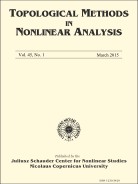Measurable patterns, necklaces and sets indiscernible by measure
DOI:
https://doi.org/10.12775/TMNA.2015.002Keywords
Equipartitions of measures, fair division, pattern avoidance, computational topologyAbstract
In some recent papers the classical `splitting necklace theorem' is linked in an interesting way with a geometric `pattern avoidance problem', see Alon et al. (Proc. Amer. Math. Soc., 2009), Grytczuk and Lubawski (arXiv:1209.1809 [math.CO]), and Laso\'{n} (arXiv:1304.5390v1 [math.CO]). Following these authors we explore the topological constraints on the existence of a (relaxed) measurable coloring of $\mathbb{R}^d$ such that any two distinct, non-degenerate cubes (parallelepipeds) are measure discernible. For example, motivated by a conjecture of Laso\'{n}, we show that for every collection $\mu_1,\ldots,\mu_{2d-1}$ of $2d-1$ continuous, signed locally finite measures on $\mathbb{R}^d$, there exist two nontrivial axis-aligned $d$-dimensional cuboids (rectangular parallelepipeds) $C_1$ and $C_2$ such that $\mu_i(C_1)=\mu_i(C_2)$ for each $i\in\{1,\ldots,2d-1\}$. We also show by examples that the bound $2d-1$ cannot be improved in general. These results are steps in the direction of studying general topological obstructions for the existence of non-repetitive colorings of measurable spaces.Downloads
Published
2015-03-01
How to Cite
1.
ŽIVALJEVIC, Rade and VRESĆICA, Siniša. Measurable patterns, necklaces and sets indiscernible by measure. Topological Methods in Nonlinear Analysis. Online. 1 March 2015. Vol. 45, no. 1, pp. 39 - 54. [Accessed 27 July 2024]. DOI 10.12775/TMNA.2015.002.
Issue
Section
Articles
Stats
Number of views and downloads: 0
Number of citations: 0



